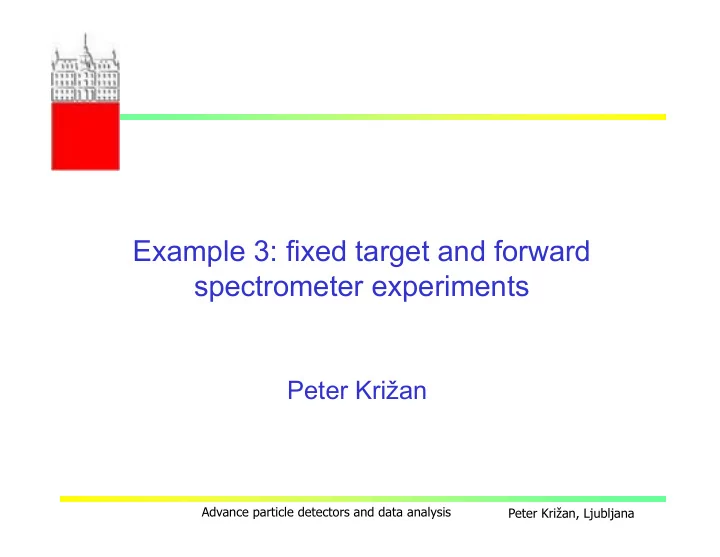

Example 3: fixed target and forward spectrometer experiments Peter Križan Advance particle detectors and data analysis Peter Križan, Ljubljana
Particle physics experiments Accelerate elementary particles, let them collide energy released in the collision is converted into mass of new particles, some of which are unstable Two ways how to do it: Fixed target experiments Collider experiments Peter Križan, Ljubljana
Experimental aparatus Detector form: symmetric for colliders with symmetric energy beams; extended in the boost direction for an asymmetric collider; very forward oriented in fixed target experiments. la b c m s p * p * target Peter Križan, Ljubljana
Example of a fixed target experiment: HERA-B Peter Križan, Ljubljana
Example of a fixed target experiment: HERA-B Peter Križan, Ljubljana
HERA-B RICH 100 m 3 of C 4 F 10 ~ 1 ton of gas Peter Križan, Ljubljana
Introduction: Why Particle ID? Without PID Example 2: HERA-B K + K - invariant mass. The K + K - decay only becomes visible after particle identification is taken into account. With PID K + K - Peter Križan, Ljubljana
b-production in pp collisions bb • Pairs of quarks are mostly produced in the forward/backward direction: σ = 500 μ b b b 10 12 b b produced per year Peter Križan, Ljubljana
LHCb LHCb is a forward spectrometer: – Acceptance 10-300 mrad – Efficient B-mesons trigger – Good Kaon/pion identification – Good invariant mass resolution – Good proper time resolution Peter Križan, Ljubljana
Peter Križan, Ljubljana
Vertex locator - VELO Vertex detector Key element surrounding the IP: Measure the position of the primary and the B d,s vertices Used in L1 trigger. Peter Križan, Ljubljana
Vertex locator • 21 pairs of silicon strip detectors arrange in two retractable halves: Strips with an R-φ geometry: – • R strip pitch: 40-102 µm • φ strip pitch: 36-97 µm 172k channels. – • Operated: In vacuum, separated from beam – vacuum by an Al foil Close to the beam line (7 mm) – Radiation ≤ 1.5 × 10 14 n eq /cm² per year – Cooled at -5 °C – Peter Križan, Ljubljana
Tracking Key elements to find tracks and to measure their momentum. Peter Križan, Ljubljana
Tracking system • Trigger Tracker: • Microstrip silicon detector Outer • 144k channels Inner • Three T stations: Inner tracker: – • Microstrip Silicon detector • 130k channels T Stations Trigger Tracker Outer tracker: – • Straw tubes (5 mm) • 56k channels Peter Križan, Ljubljana
RICH Key elements to identify pions and p 2,100 GeV c kaons in the momentum range Peter Križan, Ljubljana
LHCb RICHes RICH system divided in two detectors equipped with 3 radiators to cover the full acceptance and momentum range: •from a few GeV(tagging kaons) •up to 100 GeV: two body B decays General rule: for 3 separation, a RICH with a single radiator can cover afactor of 4-7 in momentum from threshold to the max.p. Larger region more radiators! Peter Križan, Ljubljana
RICH with three radiators Hybrid photodetector: 32 × 32 pixel sensor array (500 × 500 µm²), 20 kV operation voltage, demagnification factor ~5 Peter Križan, Ljubljana
Particle ID with RICH Efficient particle ID of π, K, p essential B 0 h + h - for selecting rare beauty and charm decays K-identification and π-misidentification 0 π + π - B d efficiencies vs. particle momentum Eur. Phys. J. C (2013) 73:2431 particle identification of 2 pions 0 π + π - B d Peter Križan, Ljubljana
Calorimeters Key element to identify Nuclear Physics, Section B 867 (2013) 1 and to measure their energy. B 0 →K*γ Used in L0 trigger. π 0 → γγ Peter Križan, Ljubljana
LHCb calorimeters • System subdivided in 3 parts: Scintillating Pad Detector (SPD) and Preshower: • Two layers of scintillator pads separated by a 1.5cm lead converter Electromagnetic Calorimeter (ECAL): • Shashlik types, • Lead+ scintillator tiles • 25 X 0 particles scintillators Hadronic calorimeter (HCAL): • – Iron + scintillator tiles fibers – 5.6 λ I • A total of 19k channels readout by Wave Length Shifter fibres connected to PMs or MaPMTs. PMT Peter Križan, Ljubljana
Particle ID with the Muon System MWPC Y 1S Y nS → µ + µ ̶ Y 2S Y 3S High detection efficiency: ε(μ) = (97.3 ± 1.2)% Low misidentification rates: ε(p → µ) = (0.21 ± 0.05)% ε(π→ µ) = (2.38 ± 0.02)% ε(K→ µ) = (1.67 ± 0.06)% Peter Križan, Ljubljana
Triggers Peter Križan, Ljubljana
Time dependent measurements at LHCb ~10 mm b b • The proper time of the signal B decay is measured via: the position of the primary and secondary vertexes; – the momentum of the signal B state from its decay products. – Peter Križan, Ljubljana
± + ± B D K K K π K s s T1 T2 T3 Trigger Tracker Vertex Locator Reconstructed event: ~72 tracks Peter Križan, Ljubljana
Flavour Tagging Tagging B Opposite side Signal B d,s Same side Opposite side: Effective tagging • e, µ from semileptonic b decays; efficiencies vary • K ± from b decays chain; between 3% and 9% • Inclusive vertex charge. depending on the final state. Same side: • K ± from fragmentation accompanying B s meson. N.B. Effective tagging efficiencies is >30% at B factories, ~2% at CDF/D0 Peter Križan, Ljubljana
Recommend
More recommend